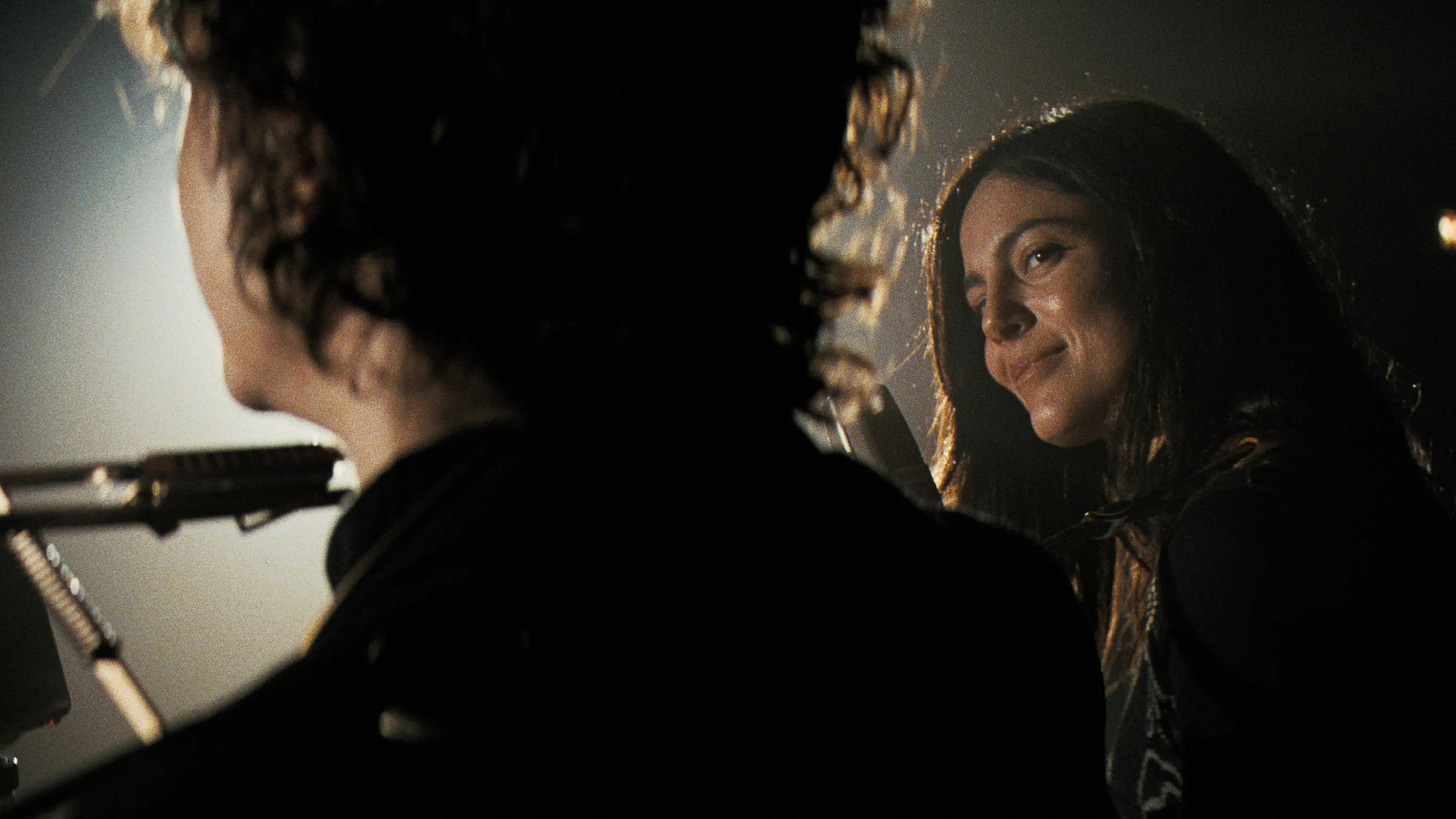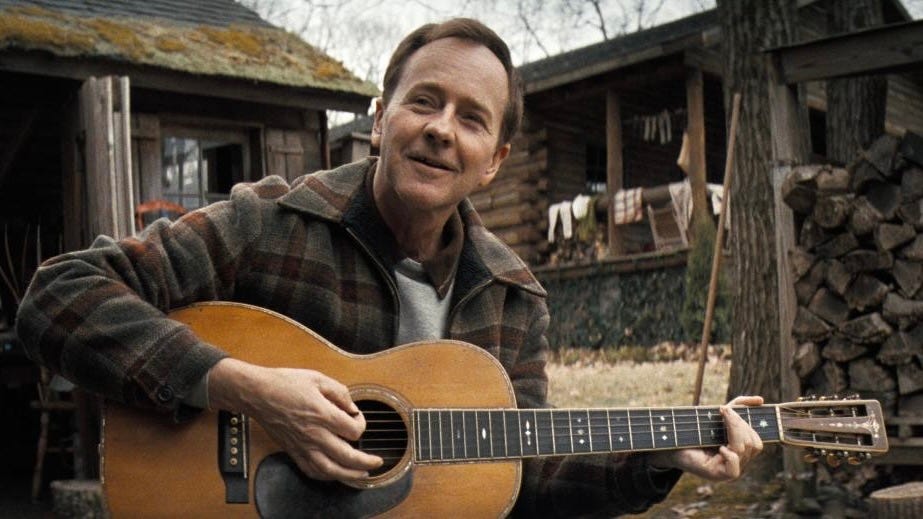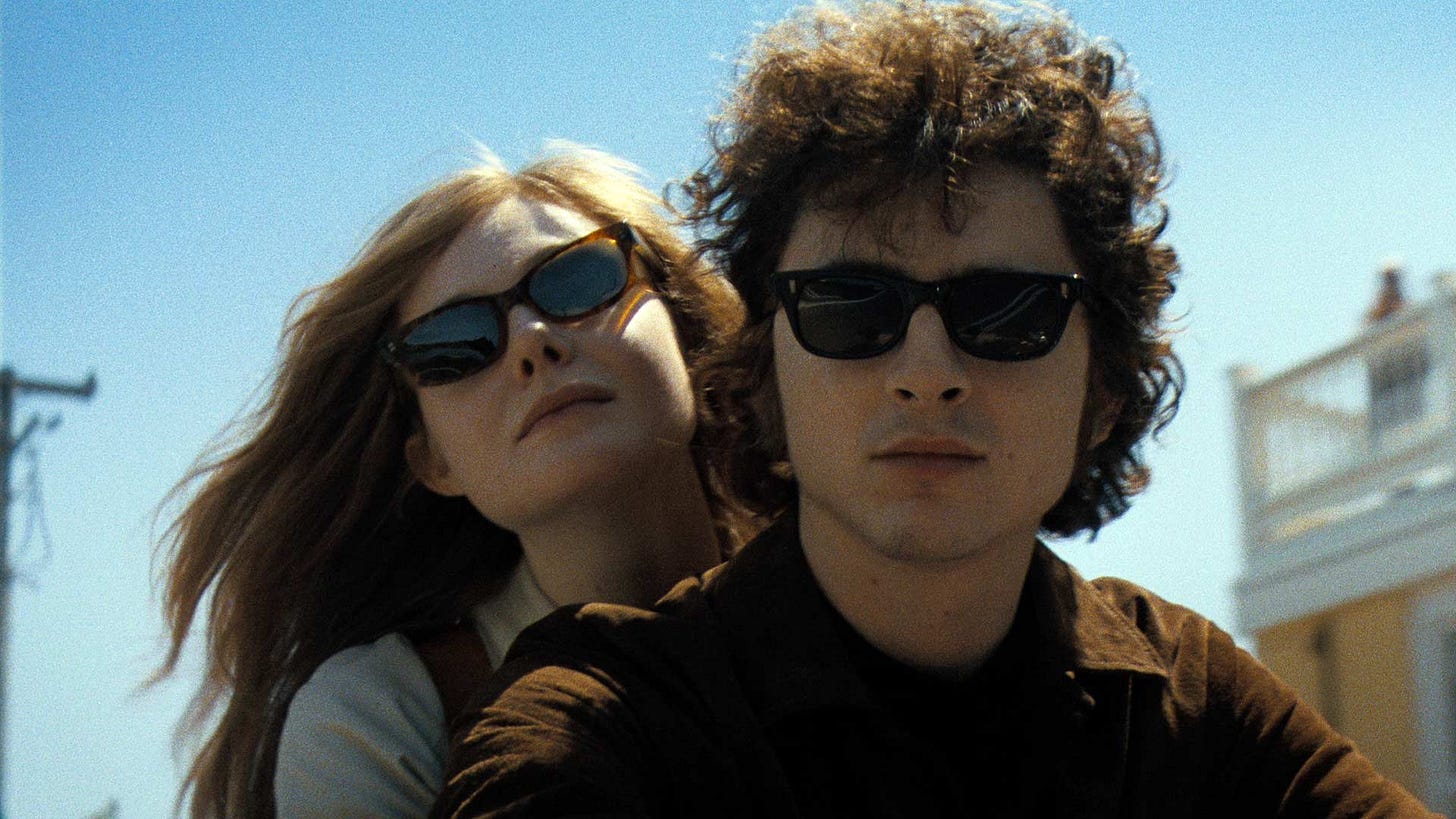Review: "A Complete Unknown" gets Bob Dylan, but fails the women around him
Better than I'd feared in most respects, but far worse in one glaring way
Did Joan Baez once run over James Mangold’s dog?
I’m sincerely trying to figure this out, because it vexes me. I actually liked A Complete Unknown much more than I was expecting to; Bob Dylan is one of two musicians (alongside Bruce Springsteen) I’d feel comfortable calling myself an expert on, to the point that I’ve given a guest lecture on his 60s work and the D.A. Pennebaker documentary Dont Look Back every year at CU Boulder for nearly a decade. There’s basically no one else I could carry so much baggage into the theater for as Bob Dylan, which makes any dramatization of his life something I’m going to be prickly and sensitive and overly-opinionated about. But for the most part, A Complete Unknown passes the smell test. It understands that the essential fact about Bob Dylan is that he cannot be understood, and that any attempt to do so forces him into another chameleonic transformation. And it knows that the closest we can get to him is through his music, so it loads up on scenes of performance, and privileges the craft of songwriting and musical experimentation in a way that precious few musical biopics ever do. Fueled by a more-than-solid lead performance from Timothée Chalamet, and a genuinely revelatory turn from Edward Norton that feels worthy of its own movie, A Complete Unknown damn near hits the nail on the head.
Except for Joan Baez.
Did the Queen of Folk once borrow a large sum of money from James Mangold and refuse to pay it back? I don’t know, and am forced to speculate, because every time A Complete Unknown would return to this borderline character-assassination of a portrayal, I found my jaw slackening in bewilderment. I don’t want to be overly harsh towards actress Monica Barbaro; her very thin singing doesn’t even vaguely evoke Baez’ legendary vocals, which is a problem when you’re trying to portray one of the single most talented vocalists in the history of popular music (yes, Baez’ voice has to be ridiculously hard to imitate – but that’s the filmmakers’ problem to solve, not mine). That said, the many issues with how the film uses (and abuses) Baez are mostly outside of Barbaro’s control, and outside the singing, she does what is asked of her just fine. The problem is that what is being asked of her is a bizarrely caustic, jealous, and small interpretation of Joan Baez that almost never tracks with anything I’ve seen, heard, or read about her.
Yes, Baez and Dylan had an on-again/off-again relationship with plenty of ups and downs; but why can’t there be a single scene in the movie that illustrates the two enjoying one another’s company? Why is every interaction so competitive, toxic, and mean? I listen to their real-life duets from this period – like the 1964 Halloween concert immortalized on the sixth volume of The Bootleg Series – and hear two people having fun bouncing off each other, even – or especially – when they’re flubbing and failing to make their vocals gel (as you can hear on “Mama, You Been on My Mind”). Mangold borrows a bit of that performance (where Baez substitutes ‘Mama’ for ‘Daddy’ and throws Dylan off balance) and transplants it to the 1965 Newport festival, and it might be charming if the two weren’t bitterly trading barbs just before they started singing.
Mangold’s film certainly understands Bob Dylan. It gets that he’s a genius less for a divinely gifted wellspring of talent than for a restless instinct for creativity and curiosity. The arc of the film is absolutely on point: Dylan rolls into town a nobody – ‘a complete unknown,’ if you will – and soon becomes so well-known, and so relentlessly pigeonholed, that he feels he has no other choice but to burn it all down and get the hell out of dodge, kicking off the series of Phoenix-like immolations and resurrections that have defined his life ever since (Dylan has been, among other things, a country singer, a Christian rock artist, and a Sinatra-style crooner, always just long enough to baffle people - and make some great music - before packing up again). The movie attitudinally understands Dylan’s point-of-view on the folk movement circa 1965: that for all its good intentions, it hypocritically embraced its own brand of conservativism in limiting what music could be, and what it expected of artists and their influences.
“Like Dylan going electric” is a popular simile for ‘making a sudden and exponential leap forward’ for a reason – because Dylan felt in his bones that music was to be relentlessly experimented with, could draw from different peoples and genres and be about so much more than a guy with a guitar. In one of my favorite moments in the film, Dylan is walking down the street when he discovers a merchant selling a slide whistle, and is enraptured with it like a kid in a toy store. I felt like standing up and cheering, because A) this is the slide whistle he’d wind up using on “Highway 61,” one of the most playful and surprising moments in the corpus of popular American music, and B) it reveals such a perfect understanding of what really drove Dylan. He could have kept singing “Blowin’ in the Wind” to sold-out crowds for years or decades, but instead he found a slide whistle and played around with his band to find a way to get it on the record. That’s Bob Dylan, and I was delighted to see Mangold and company so thoroughly get it.
So why is there no interest in ‘getting’ Joan Baez? She is not incidental to the story of Bob Dylan; she was the famous one at the outset, the one whose performance of his original songs helped Dylan break down the long-standing singer/songwriter barrier. A Complete Unknown technically portrays all this, but in a way that makes Baez come across as a small-minded hack, a stepping stone for a Great Man of History to walk over on his way to the top. She’s depicted as jealous of Dylan’s talent, and Dylan appears to be unmoved by hers. There are many (too many) scenes of Baez gazing on Dylan in awe, transfixed (and frustrated) by his skill and imagination. Why are there no scenes going in the other direction? Bob Dylan will be the first to tell you – provided you can get him in the room to talk – what a revelation Baez was. In a 2017 interview, he was asked what he thought of Baez, and spontaneously delivered this poetic ode to her voice:
“She was something else, almost too much to take. Her voice was like that of siren from off some Greek island. Just the sound of it could put you into a spell. She was an enchantress. You’d have to get yourself strapped to the mast like Odysseus and plug up your ears so you wouldn’t hear her. She’d make you forget who you were.”
Why isn’t that sentiment anywhere to be found in A Complete Unknown? Why is there no sequence of Chalamet watching her sing, enchanted like Odysseus, briefly forgetting to keep up the armor he constantly constructs around himself? When I teach Dont Look Back, I always pair it with clips of Murray Lerner’s Festival, a fantastic 1965 documentary on the Newport Folk Festival that happens to include a lot of wonderful footage of Baez not only performing, but verbally giving her perspective on the contemporary folk scene. It’s invaluable. When I show a clip of her singing “All My Trials” at the 1964 festival, you can feel the energy in the classroom change. Her voice does that. It’s almost like being hypnotized. No one is immune to it – especially not Bob Dylan.
A Complete Unknown comports itself well with other side characters. Edward Norton’s take on Pete Seeger is just wonderful, an endlessly charming performance that’s also dripping with pathos. Seeger’s arc – of thinking he has finally found a messiah capable of ‘saving’ folk music, and having to eventually accept that such a role cannot reasonably be forced on an individual – is the spine upon which so much of the film’s humanity rests; and for all I liked about A Complete Unknown, I found it impossible not to wish, at least a little bit, that I was watching a film about Seeger instead, one with Norton front and center. I similarly found myself daydreaming of a Walk the Line remake whenever Boyd Holbrook showed up as Johnny Cash; as good as Joaquin Phoenix was in the 2005 film, Holbrook is even better (particularly when it comes to singing – he is able to replicate Cash’s bass in a way Phoenix never could). Both Seeger and Cash work here not merely as stirring evocations of great 20th century musicians, but as figures whose influence (and, sometimes, friction) in Dylan’s life is sharply and sensitively articulated.
So why is Mangold’s film so disinterested in giving Baez similar due? During a montage set to “A Hard Rain’s A-Gonna Fall,” which encompasses the brief period of Dylan as a political protest singer, we see Dylan performing at the March on Washington. In reality, he wasn’t there alone; he was performing with Joan Baez, and at that point, just three months after The Freewheelin’ Bob Dylan released, she was probably still the bigger draw. The film portrays her ambition in a negative light, showing her as constantly threatened by Dylan’s meteoric rise, ultimately bitter about who he becomes; the nature of Dylan’s own ambition isn’t considered much, if at all. Baez, ultimately, isn’t a fellow artist and sometimes lover whose own work and personality deeply marked Dylan’s career, but a rival whose personal smallness mainly serves to illustrate Dylan’s artistic largesse. Whatever I was expecting (or dreading) from this film, ‘bizarrely bitter take on Joan Baez that feels like someone is settling personal beef’ wasn’t on the list.
Chalamet is, lest it go unsaid, very good. It is an extremely studied take on Dylan, one whose many tics and mannerisms will be familiar to those who know all the footage that exists from this period. I was impressed right off the bat, when Chalamet performs “Song for Woody,” to see him imitate small details like the way Dylan always nods his head forward on plosives while singing. Chalamet’s voice struggles a tad in the upper register, in a way that betrays this isn’t entirely natural to him, but he evokes Dylan’s vocals just fine. And more importantly, he manages to let a genuine performance shine through the imitation, one that captures both Dylan’s essentially mercurial qualities and the deep-seated discomfort he has whenever someone attempts to start ‘understanding’ or pinning him down. Chalamet also, crucially, gets Dylan’s humor – that unique mixture of biting and childish you hear from Dylan in the period, where he can go from cold or unlikable to disarmingly funny in brief, charming snippets.
Part of why Chalamet is even allowed to be so good here is that Mangold has asked his actors to perform all the songs, as he did in Walk the Line. That’s crucial. Rami Malek may have won an Oscar for lip-syncing to Queen, but the truth is you can never actually embody a musician without doing what they do, and extending one’s performance to the act of music-making itself. And the single most commendable quality of A Complete Unknown is how fulsomely engaged with the music it is: not just in the performances, where the actors get to build character through how they play and sing and hold themselves on stage, but also in the amount of screentime devoted to the craft of songwriting and the chemistry between musicians when they try things out together.
The best scene in the entire film – and honestly one of my favorites of 2024 – comes when Dylan shows up late to Pete Seeger’s educational TV show, and encounters a blues musician (Jesse Moffette, played wonderfully by Big Bill Morganfield) who had been called up to take Dylan’s spot. Instead of hogging the spotlight and playing one of his hits, Dylan starts asking questions about Moffette’s guitar and technique, displaying an infectious enthusiasm for the blues; Moffette hands his guitar over, and he and Dylan start an impromptu jam session. The sequence is delightful in and of itself, a great little vignette about the beauty of artistic curiosity, but it’s also an essential character-building moment, as Seeger starts to realize his would-be Messiah will never be content to keep doing the same thing forever – and glimpses, for the first time, the value in Dylan’s restless reinvention.
But for all A Complete Unknown gives, it also takes away. Baez is not, unfortunately, the only woman failed by Mangold’s film, with Elle Fanning stranded in an utterly thankless role as Dylan’s girlfriend Suze Rotolo (here renamed Sylvie Russo). Fanning’s only real job in the film is to stare at Dylan, while he plays or writes songs or interacts with others, and make her lip quiver and eyes tear up, because Dylan is just too brilliant, too aloof, too distant and unknowable and something something something. It becomes tiresome fast, and offensively patronizing not long after. The film does just fine illustrating the eternal mystery that is Bob Dylan without reducing one of its two female leads to a blubbering mess every time she is on screen, or making the other constantly jealous and bitter of his success.
When I watch how the real-life Dylan interacts with the real-life Baez in Dont Look Back, I don’t see a genius ubermensch unable to forge meaningful relationships with women because of his infinite distance from them. I instead see a guy in his mid-twenties who is distracted and self-absorbed and kind of a shitty boyfriend. Not monstrous, nor abusive; just immature and emotionally unavailable in a way twenty-somethings often are. This is Dylan at his most quotidian and human: a kid who, like most of us at that age, didn’t have his shit together enough to engage in a stable romantic partnership. The fact of the matter is that A Complete Unknown had more than enough to pull on to illustrate what makes Dylan singular without throwing the women in his life under the bus. And as pleasantly surprised as I am to find myself liking so much of what this film has to offer, I cannot shake this giant gendered gap at its center, this sex-based polarity between ‘insightful’ and ‘utterly tone deaf’ that leaves me a little confused, a little offended, and desperately wracking my brain to figure out where Joan Baez and James Mangold would have run into each other, and what on earth she did to deserve this.
Read the book 200 Reviews by Jonathan R. Lack in Paperback or on Kindle
Subscribe to PURELY ACADEMIC, our monthly variety podcast about movies, video games, TV, and more
Like anime? Listen to the podcast I host with Sean Chapman, JAPANIMATION STATION, where we review all sorts of anime every week. Watch on YouTube or Subscribe wherever you get your podcasts.






I left the theater so angry and not entirely sure why I felt like I wanted to kick the shins of every man in the lobby. OK, maybe it's because I was a rock singer during Bob's era and believe me, the misogyny was thick as buttah. But my anger is also grounded in my academic background as a writing and lit professor whose specialty is silence in women. (I'm writing my second book about the way women are silenced). Perhaps, as you note, Dylan was a product of his times, but Mangold is alive today and his portrayal of Joan Baez is deeply offensive. His reductive treatment of Susie (Bob's girlfriend) is patriarchal, small-minded, and infuriating. He makes me want to speak only in four-letter words. I'm grateful for your precise and careful critique of the film and your support of women's voices! Bravo! BTW, I did like the film and love Dylan.
Excellent synopsis. I left the theater wondering where the women were in the making of the film, and why Baez was so moody and shortchanged. The voice also left me flat. I hope other women and progressive men weigh in here as well.